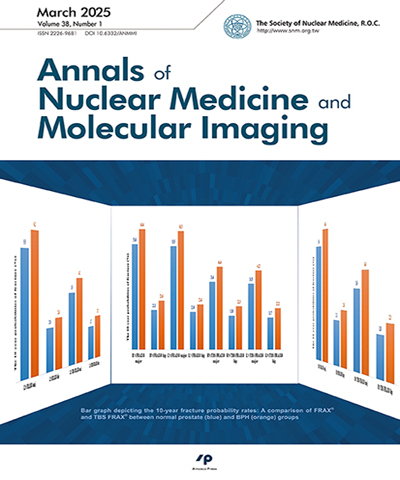
核子醫學暨分子影像雜誌/Annals of Nuclear Medicine and Molecular Imaging
中華民國核醫學學會 & Ainosco Press,正常發行
選擇卷期
- 期刊
背景:本研究的目的是比較使用time-of-flight(TOF)與point-spread-function(PSF)影像重建參數前後對標準攝取值standardized uptake value(SUV)的影響。方法:本回溯性研究收集從2015年1月至2015年6月間為了健康檢查而進行全身FDG-positron emission tomography/computed tomography(PET/CT)掃描,經篩選後總共有107位受檢者(男性50位,女性57位)符合條件。FDG-PET/CT影像重建分為只使用ordered subset expectation maximization(OSEM)與使用OSEM+TOF+PSF(ultraHD-PET)進行比較,再利用影像後處理軟體圈選不同器官和組織感興趣區域(region of interest, ROI),獲得FDG-PET/CT的最大標準攝取值。利用配對樣本t檢定(paired sample t-test)、相關係數,分析兩種影像重建方式之間標準攝取值的差異與相關性。結果:本研究所測量器官組織中只使用OSEM與ultraHD-PET的SUV皆為正相關,且除了肝臟外,其餘皆有統計學上顯著性差異。大多數器官組織使用ultraHD-PET比只使用OSEM所測量到的SUV值會顯著偏高,但因部分體積效應(partial-volume effect)影響下口咽、舌、膽囊與攝護腺反之。結論:臨床使用上,建議使用同一種影像重建方式進行影像診斷的輔助,避免使核醫科醫師和臨床醫師產生困惑。
- 期刊
身體活動(physical activity, PA)影響健身運動相關的心理生理效應(exercise-related psychological effect)之神經生化機制,至今已有許多研究透過腦電圖(electroencephalography, EEG)、腦磁圖(magnetoencephalography, MEG)、結構性磁振影像(structural magnetic resonance imaging, sMRI)、功能性磁振影像(functional magnetic resonance imaging, fMRI),正子斷層影像(positron emission tomography, PET)以探索在不同運動活動習慣下大腦認知功能的狀況。透過量化分析腦部醫學影像得到大腦在不同認知程度下的量化資訊,其中,sMRI結構影像分析大腦組織體積,fMRI功能性影像分析大腦血氧變化,PET分子影像量化大腦代謝分子的攝取,藉由量化分析腦部醫學影像的資訊,來衡量PA活躍程度與認知程度的關聯性。將fMRI與PET兩種模態的功能性影像結合,以此混合式影像(hybrid imaging)探索大腦與不同運動習慣的認知功能程度之關聯性在國內外並不多見,但可對於因PA(急性或慢性)介入產生之大腦認知功能變化提供更多探索的潛能。此篇文獻回顧主要探討藉由腦部醫學影像,呈現運動介入在改善疾病和不同運動習慣、強度和類型上的影像,並將量化分析腦部醫學影像後得到的數據,經統計分析其與認知功能表現上的關聯性。
- 期刊
We described a case report of a 52-year-old patient with nonkeratinizing carcinoma of nasopharynx (cT2N0M0, stage II) who received Tc-99m methylene diphosphonate (MDP) bone scintigraphy for tumor restaging. During the examination, a new area of increased MDP uptake at the junction between the T9 and T10 vertebral bodies was found. The patient had no history of trauma or surgery at the thoracic spine, and there also were no local fever, pain, and other symptoms and signs of systemic infection. A single-photon emission computed tomography/computed tomography (SPECT/CT) was arranged for further evaluation, and intervertebral disc calcification was suspected according to the characteristics of CT images and following clinical course. Since only a few cases of asymptomatic disc calcification have been reported on Tc-99m MDP bone scans, we shared this uncommon case.
- 期刊
We reported two cases of papillary thyroid cancer with distant metastases but no evidence of lymph node metastases. Case one had a focus of papillary carcinoma, 1.3 cm in size, without evidence of microscopic extrathyroid extension, lymphovascular invasion or lymph node metastasis. She received 30 mCi of radioactive iodine for remnant ablation but whole-body imaging showed multiple foci of lung metastases incidentally. Case two went to our emergency room with symptoms of spinal cord compression. Computed tomography scan and magnetic resonance imaging showed a space-occupying lesion at the T9 vertebral body. Surgery was performed and the pathological report revealed metastatic thyroid cancer. She received total thyroidectomy and the pathological report revealed a 4.0 cm-sized lesion of invasive encapsulated follicular variant of papillary thyroid carcinoma in the right lobe. Whole-body single-photon emission computed tomography/computed tomography imaging after 200 mCi of radioactive iodine showed multiple lesions in the lungs, T-spine, left lower rib cage, left ischium, and right femur. The recommendations about radioactive iodine therapy in low-risk patients and the characteristics of invasive encapsulated follicular variant of papillary thyroid carcinoma were discussed.
- 期刊
A bone scan is typically used as a routine primary staging test for prostate cancer to detect bone metastases. However, a bone scan using Tc-99m methylene diphosphonate (Tc-99m MDP) is an indirect method to detect bone metastases. We presented a case in which the bone scan completely missed diffuse osteolytic bone metastases in a patient with prostate adenocarcinoma. A 68-year- old male visited our Orthopedics outpatient department due to low back pain lasting for 10 days. A magnetic resonance imaging of the lumbar spine revealed multifocal bone marrow signal changes in the thoracolumbar, sacral spine, and pelvic bones. Prostatic adenocarcinoma was diagnosed by bone marrow aspiration, with a serum prostate-specific antigen level of 3,573 ng/mL. Computed tomography images showed diffused bony metastases in the spine and rib fractures. However, the bone scan of this patient only suggested degenerative spine disease and post-traumatic responses at the ribs. Our case demonstrates a significant discrepancy between diffuse bone metastases involvement and a negative bone scan image. We should raise awareness of false-negative bone scans in patients with a high risk of advanced prostate cancer, especially in the presence of pure osteolytic bone metastasis.
- 期刊
A 16-year-old male patient had been experiencing fever, productive cough, and sore throat for two weeks. Upon we conducted a thorough investigation, a biopsy was taken from the subcutaneous lesions on the anterior abdominal wall, which revealed subcutaneous panniculitis-like T-cell lymphoma (SPTCL). This rare disorder is often mistaken for panniculitis. The F-18 fluorodeoxyglucose positron emission tomography/ computed tomography (FDG PET/CT) scan confirmed the involvement of lymphoma in the subcutaneous lesions of the neck, thorax, abdomen, pelvis, and bilateral upper and lower extremities. A follow-up image taken six months after treatment showed almost complete resolution, except for a few residual tumors in the lower legs. A true whole-body PET scan, from head to both feet, is necessary for the staging and assessing therapeutic response of SPTCL.
- 期刊
A 68-year-old male suffered from left-side weakness two weeks ago. The brain computed tomography (CT) showed acute ischemic infarction of the right basal ganglia, stenosis of the left proximal subclavian artery, and right proximal intracranial artery. A liver function abnormality was found. He was treated for drug-induced liver failure. The liver function is gradually normal after the drug was discontinued. After admission, due to suspecting of urinary tract infection the positron emission tomography/computed tomography (PET/CT) scan was done and showed increased FDG uptake in the aorta, carotid, and subclavian arteries. The impression is vasculitis. However, the sudden onset of slurred speech with facial palsy was noticed the next day. The brain CT and CT angiography showed right basal ganglia infarction with moderate stenosis of the left proximal subclavian artery and severe stenosis of the right proximal internal carotid artery. The antiplatelet therapy was prescribed. Many times of sudden onset slurred speech and motor aphasia in the evening, till his condition improved after two weeks of treatment, and no more neurological symptoms were observed. After we know the patient is a Japanese descendant, we arranged an aorta CT for suspecting Takayasu arteritis (TAK), and the result showed large vessel involvement with multifocal short-segment stenosis of visceral arteries near the ostium, compatible with TAK. Due to highly suspected TAK, a high-dose steroid was used. No specific discomfort was mentioned after that. In this case, we know the patient has some kind of large vessel inflammation after the FDG-PET/CT was done. FDG-PET/CT has an important role in the diagnosis of extracranial vascular involvement in patients with large vessel vasculitis.

